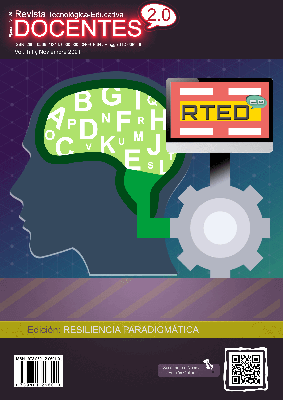Incidence of Creative Processes in Visual Arts Students
 DOI:
https://doi.org/10.37843/rted.v1i1.232
DOI:
https://doi.org/10.37843/rted.v1i1.232
Main Article Content
Abstract
In the history of humanity focused on art, specifically on drawing and painting, there is the ability to represent reals, fictitious or abstract images on a surface, which can be very diverse and with different pigments. This research's objective was to analyze and incidence of the creative processes in the learning of the graphic-plastic expression of the portrait-self-portrait in the students of the first semester of Visual Arts, University of Pamplona. Therefore, was carried out a bibliographic review on the relevant aspects of the theory studied and the works in the international, national, and regional fields, which were very useful for the methodological design, approach, strategy, and analysis. From the results. The type of research was qualitative with the phenomenological method and began with a diagnostic stage where it was possible to establish a population characterized by five first-semester students plus three teachers who were of great importance for their contributions. With their subsequent analysis, information and discussion, the results led to the main conclusion: the creative processes did influence when drawing a face, knowing as a requirement a very acute perception since, for this reason, the graphic-plastic expression of the portrait- Self-portrait is very compelling for those who are learning to see and draw.
Downloads
Metrics
Article Details

This work is licensed under a Creative Commons Attribution-NonCommercial-NoDerivatives 4.0 International License.
Those authors who have publications in our journal accept the following terms:
- When a work is accepted for publication, the author retains rights of reproduction, distribution of his/her article for exploitation in all countries of the world in the format provided by our magazine and any other magnetic medium, optical, and digital.
- Authors will retain their copyright and guarantee the journal the right first to publish their work, which will be simultaneously subject to the Creative Commons Acknowledgment License (Attribution-NonCommercial-NoDerivatives 4.0 International (CC BY-NC-ND 4.0)). That allows third parties to copy and redistribute the material in any medium or format, under the following conditions: Acknowledgment - You must properly acknowledge authorship, provide a link to the license, and indicate if any changes have been made. You may do so in any reasonable way, but not in a way that suggests you have the licensor's endorsement or receive it for your use. NonCommercial - You may not use the material for a commercial purpose. NoDerivatives - If you remix, transform, or build from the material, you cannot broadcast the modified material. There are no additional restrictions - You cannot apply legal terms or technological measures that legally restrict you from doing what the license allows.
- Authors may adopt other non-exclusive license agreements to distribute the published version of the work (e.g., deposit it in an institutional archive or publish it in a monographic volume) provided that the initial publication in this journal is indicated.
- Authors are allowed and recommended to disseminate their work through the Internet (e.g., in institutional telematic archives, repositories, libraries, or their website), producing exciting exchanges and increasing the published work's citations.
- Request of withdrawal an article has to be done in writing by the author to the Editor, becoming effective after a written response from the Editor. For this purpose, the author or authors will send correspondence via e-mail: [email protected].
- The author will not receive financial compensation for the publication of his work.
- All Docentes 2.0 Journal publications are under the Open Journal System (OJS) platform at: https://ojs.docentes20.com/.
References
Araque-Hurtado. L (2016). El autorretrato como medio de catarsis investigación-creación pictórica. (trabajo de grado). Universidad Tecnológica de Pereira.
Báscones-Reina., N. (2014). Concepto actual del autorretrato en la obra del artista contemporáneo y la búsqueda de la identidad en la práctica artística. (Tesis Doctoral) Valladolid.
Benavidez-Penagos, G., Arias-González, M. Perassi, M.., & Castiblanco-Venegas, Y. (2021). Comunicación Participativa en la Academia: Construyendo Tejido Social desde la Memoria Histórica. Revista Tecnológica-Educativa Docentes 2.0, 11(1), 27–35. https://doi.org/10.37843/rted.v11i1.182 DOI: https://doi.org/10.37843/rted.v11i1.182
Bula-Escobar, G. (2020). Serie lineamientos curriculares Educación Artística. Ministerio de Educación Nacional.
Edwards, B. (1984). Aprender a dibujar con el lado derecho del cerebro. LAVEL. Polígono Los Llanos.
Estrada-Herrero, D. (1998). Estética. Editorial Herder.
Hernández-Sampieri, R., Fernández-Collado, C. & Baptista-Lucio, P. (2006). Metodología de la Investigación. McGraw Hill.
Husserl, E. (1931). Fenomenología y Antropología. En: Anuario de Filosofía Jurídica y Social (1985). Sociedad Chilena de Filosofía Jurídica y Social. Traducción de Raúl Velozo.
Loomis, A. (1959). Dibujo de Cabeza y manos. The Viking Press.
López-Jiménez, D. (2003). El consumo crítico de los medios de la juventud y el lenguaje de la discreción como propuesta pedagógica.
Rodríguez-Gómez, G. Gil-Flores, J. & García-Jiménez, E. (1996). Metodología de la Investigación cualitativa. Ediciones Aljibe.
Sanz-Lobo, E. (2003). Procesos creativos: problemas y arte. En Congreso INARS: la investigación en las artes plásticas y visuales. Universidad de Sevilla
Taylor, S.J. & Bogdan, R. (1984). Introducción a los métodos cualitativos de investigación – La búsqueda de significados. Paidós Barcelona.
Thomas, J.R., Nelson, J. K. & Silverman, S.J. (2005). Research Methods in Physical Activity. Fifth edition. Human Kinetics.






